#john c fremont
Explore tagged Tumblr posts
Text
jzx!john fremont and jyl!jessie benton i've cracked the code and in the process blasphemed but it works as long as you tweak it a bit i promise.
1 note
·
View note
Text
The Piñon Pine - The Indians Own Tree
When I section-hiked the PCT from Tehachapi to Walker Pass several Mays ago, as we neared the northern end of that trip we took a lunch break one day under a grove of piñon pines. As we reached into our pack for our usual lunch of cheese, rye crackers, and salami, we began to notice that the forest floor was littered with pine nuts. While some had become food for rodents, squirrels, and other foraging animals since dropping to the ground the prior autumn, most were so very edible. Soon we were each on our hands and knees collecting cones and harvesting their delectable contents ($29 a pound at our local co-op). I ate my fill and packed an empty bag with more nuts which I brought home with me when I left the trail. This is David Foscue’s story of the pine nut.
David Foscue
An Evolutionary Feat
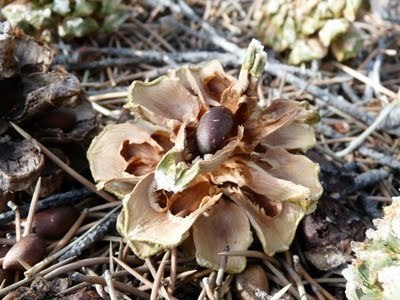
Piñons are coveted for their nutitious seeds. One pound of seeds may contain 3,000 calories. The pine nuts were collected by Indians as stores for the winter. Listen again to Muir: “This is undoubtably the more important food-tree on the Sierra, and furnishes the Mono, Carson, and Walker River Indians with more and better nuts than all the other species together. It is the Indian’s own tree, and many a white many they have killed for cutting it down.”
A diligent collector in the prime collecting time can gather up to seventy pounds of the seeds. Humans, of course, are not the only beneficiaries of the piñon’s largess. Pine nuts are a favorite of many animals from the piñon jay to the pack rat — it is reported that over forty pounds of nuts may be found in a pack rat’s cache. The wide popularity of piñon nuts is a matter of survival, for the seeds of the piñon lack wings and depend on animals for distribution.
The piñon of the Sierras is single-needled pine. It is a mutation of the piñon found further east on which the needles appear in bunches of two. The two-needled piñon is subject to infestation by the piñon spindle gall midge which appears to have evolved with the tree. The insect lays its eggs on the flat leaves, when they hatch the larvae crawl into the crotch between paired needles. The irritation caused by the tiny larvae simulates the plant to grow tissue forming a gall over the larval wound. The gall covers the wound but it also protects the enclosed larvae.
The gall midge evolved to inhabit the single-needled piñon which lack the needle crotches to shelter the larvae. According to Ronald Lanner, the single-needle piñon developed from the twin-needled variety but “one of the potential needle sites is suppressed by the … mutation. Our gall midge neutralizes the mutation. The feeding of the larvae suppresses the needle-suppression mechanism, allowing both of the potential needles to develop, though they reach only a fraction of their full length. The needles are galled and the larvae grow up in the same type of needle-crotch home as those in … two needled pines.” Needles at unaffected locations on the tree remain single.
Kit Carson, John C. Frémont and the Piñon Nut
The piñon played a supporting role in two dramas that have become part of the lore of the PCT. One involved “The Pathfinder,” John C. Frémont, extraordinary adventurer and the first Republican presidential candidate. The other tale involves the ill-fated Donner party.
Frémont, and his scout, Kit Carson, led the first recorded winter crossing of the Sierras. What Frémont expected to take a week became an ordeal of five weeks. As they faced the Sierras their supplies were running low. Fortunately Indians supplied them with pine nuts! On January 24, 1844, Frémont wrote:
A man was discovered running towards the camp as we were about to start this morning, who proved to be an Indian of rather advanced age–a sort of forlorn hope, who seemed to have been worked up into the resolution of visiting the strangers who were passing through the country. He seized the hand of the first man he met as he came up, out of breath, and held on, as if to assure himself of protection. He brought with him, in a little skin bag, a few pounds of the seeds of a pine-tree … . We purchased them all from him.
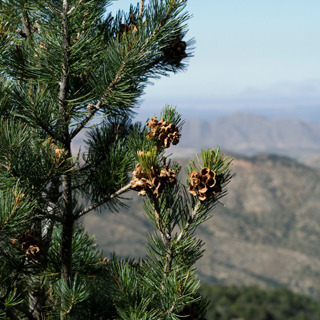
The Donner Party - Rescued by Pine Nuts?
George Donner’s group was not as successful in its attempt to cross the Sierras two winters later. In a snow storm, the party reached what is now known as Donner Lake in early November 1846. Attempts to reach the pass failed and the party returned to the lake and settled in. Although many of their animals froze providing unexpected food, their provisions were soon exhausted and the new settlers faced slow starvation.
On December 16 a group of fifteen left the lake in an attempt to cross the mountains for help. Using the same term Frémont applied to the old Indian who first provided him piñon nuts, they called themselves the “Forlorn Hope Party.” Death reduced the group to seven. As we now know, the dead sustained the living.
The forlorn and depleted party finally came to an Indian village on January 10. The Indians provided acorn bread to the party but the group was so weakened their strength could not be restored. The leader, William Eddy, became sick on the bread. Donner’s Daughter, Eliza, writes how Eddy regained his strength:
… the chief with much difficulty procured for Mr. Eddy, a gill of pine nuts which the latter found so nutritious that the following morning, on resuming travel, he was able to walk without support.
Eddy walked fifteen miles that day to a small settlement where he was able to organize a party to rescue the other six surviving members of Forlorn Hope. Eventually three rescue parties, including one led by Eddy, were organized to return to Donner Lake. Forty-six members of the Donner party were rescued. Forty-two did not make it. The toll surely would have been greater but for the pine nuts given by the Indians to Eddy.
Think about the Donner party the next time you sprinkle piñon pine nuts on your salad.
2 notes
·
View notes
Text
EPISODE #237 SURROUNDED IN THE NIGHT
A winter storm cut loose from the mountains, the cold wind whipping around the creosote, rain dripping down through the swamp-cooler vent: 2025 came in like a Lion and it’s the Year of the Snake. We’ve got both out here, in the Mojave Wilderness. Mountain lions. And snakes. Although it’s still a bit early to see our reptile friends up here at 4,000-feet elevation. PLUS: Frontier Tales from the…

View On WordPress
5 notes
·
View notes
Text
"Wonder of the West" by Stephen G. Yanoff
Ambition, Perseverance, and Adventure #books #bookreview #reading #readerviews
Wonder of the West Stephen G. YanoffAuthorHouse (2024)ISBN: 979-8823024440Reviewed by Ashley Hooker for Reader Views (08/2024) Wonder of the West: The Adventurous Life of John C. Fremont by Stephen G. Yanoff is one of his non-fiction works, a historical biography. I previously read some of the author’s fictional work and was curious about his ability to create a non-fiction read. As I…
#AuthorHouse#Book Review#Reader Views#Stephen G. Yanoff#The Adventurous Life of John C Fremont#Wonder of the West
0 notes
Text
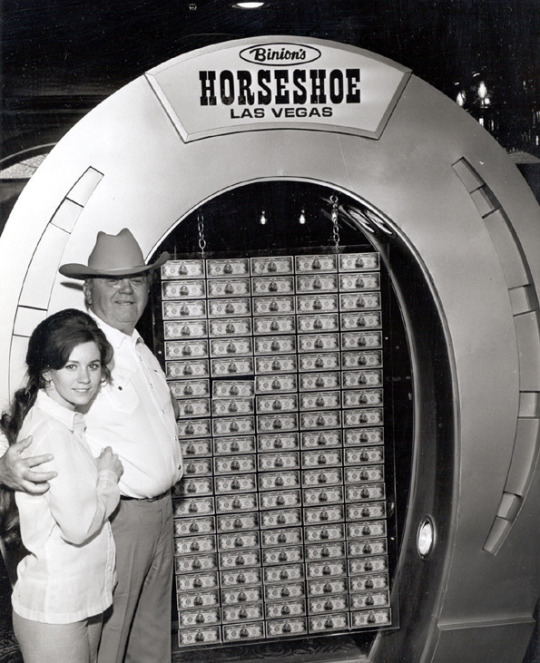
Benny Binion, daughter Becky, and the unveiling of the second Million Dollar Display at the Horseshoe, Las Vegas, June 4, 1969.
The $1M display – one hundred $10,000 gold certificates – was conceived by Binion and first introduced Dec. ‘54 while the Horseshoe Club was under management of Joe W. Brown. The display was the original tourist photo op in Las Vegas, and one of its most enduring.
Joe W. Brown, who took over the Horseshoe Club when Binion was sent to prison, paid for and ordered the display's one hundred $10k Salmon P. Chase Federal Reserve Notes from the Denver Mint. Brown sold his interest in the club to Ed Levinson and the Fremont Hotel partners in '58, and died in ‘59. The bills left to his estate and the display was removed.
Benny Binion brought back the display in June 1969 after a years-long effort to collect another hundred of the $10k notes.
After Benny Binion's death, control of the club passed to Becky Behnen, who sold the bills to a collector in ‘99. What happened to the display itself is unknown.
Later owners of the casino as Binion's Gambling Hall, created their own Million Dollar Display in 2008 with $1, 20, and 100 bills.
Caesars Entertainment, the subsequent owner of the Horseshoe name and World Series of Poker brand, created replica of the Horseshoe display exhibited elsewhere stocked with replica bank notes.

12/10/54 – Grand opening announcement for the million dollar display, and Horseshoe Club's new annex on South 2nd St.
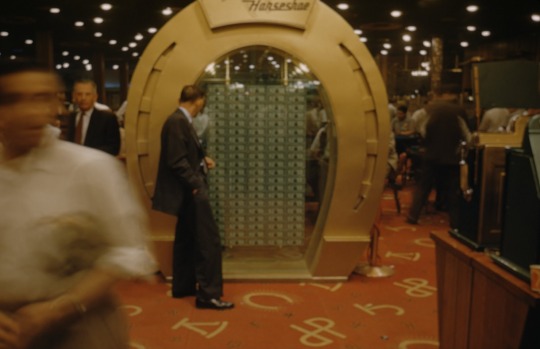
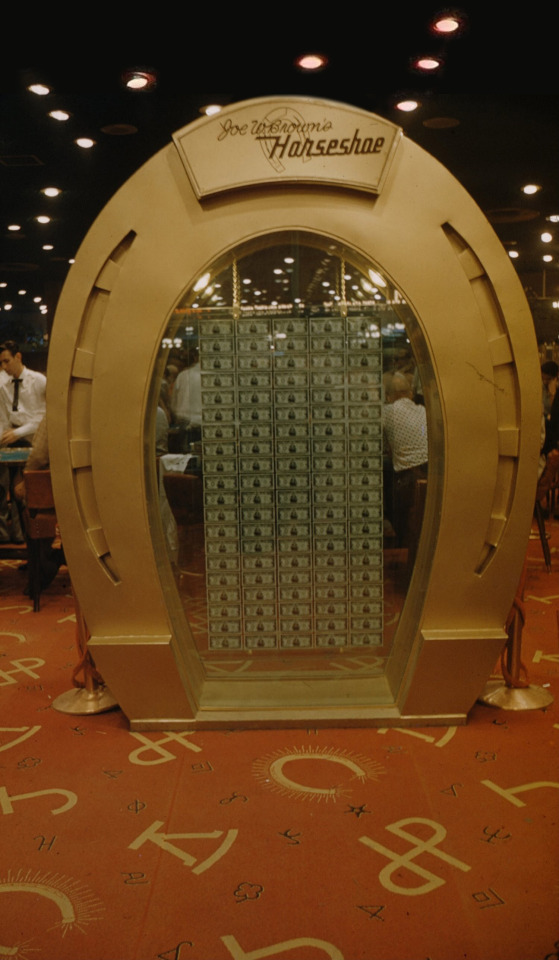
The original $1M display at Joe W. Brown’s Horseshoe Club. Photos by Loomis Dean, circa May '55


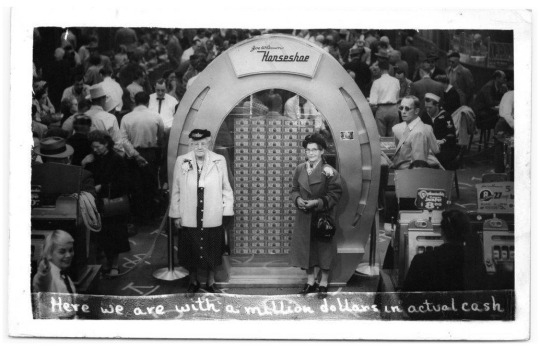
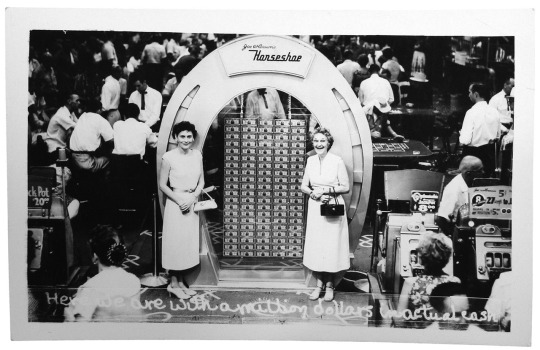




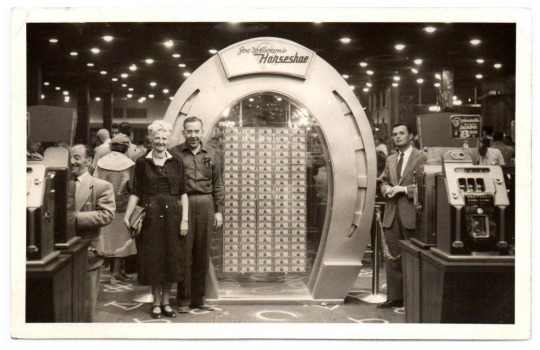

Horseshoe set up a system for tourist postcards, and produced thousands over the years. Mayme Stocker on the right in the first photo, with Marion and Herbert Hyatt (Harold Stocker Photographs PH-00006, UNLV Special Collections). Other postcards are unknown circa '54-59.
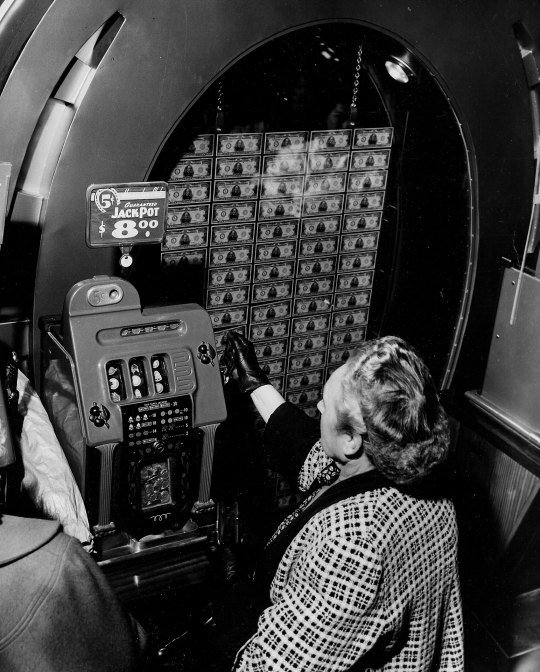
1/1/55 – Photo by Las Vegas News Bureau.

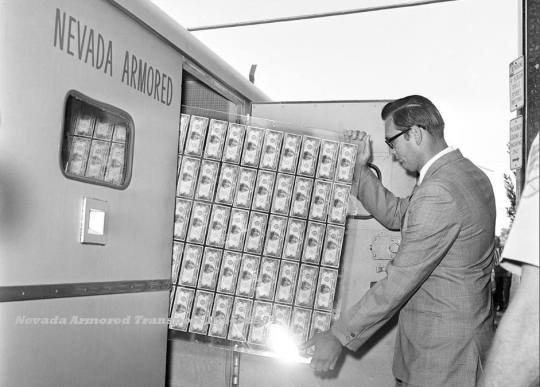
Creating and transporting the second Million Dollar Display at Bank of Las Vegas, 6/4/69. Photos by Terry Todd, Las Vegas News Bureau, via Nevada Armored Transport.
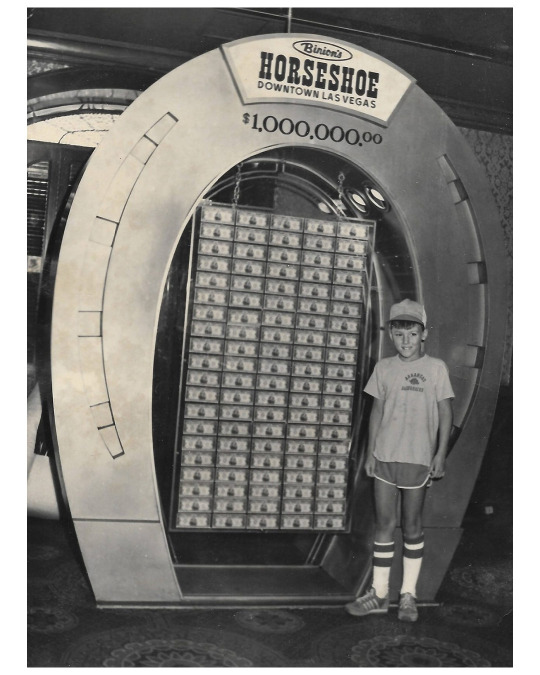


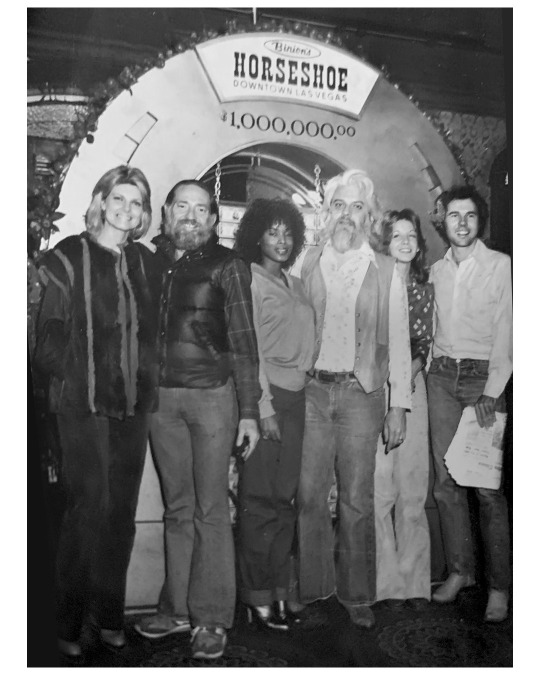
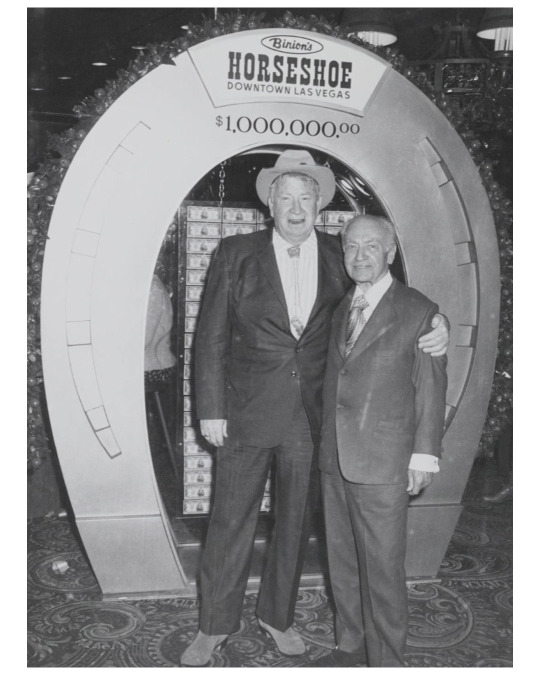

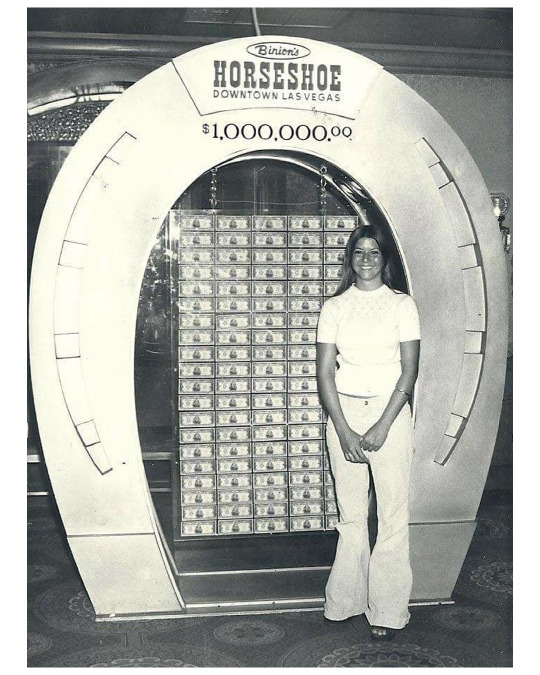

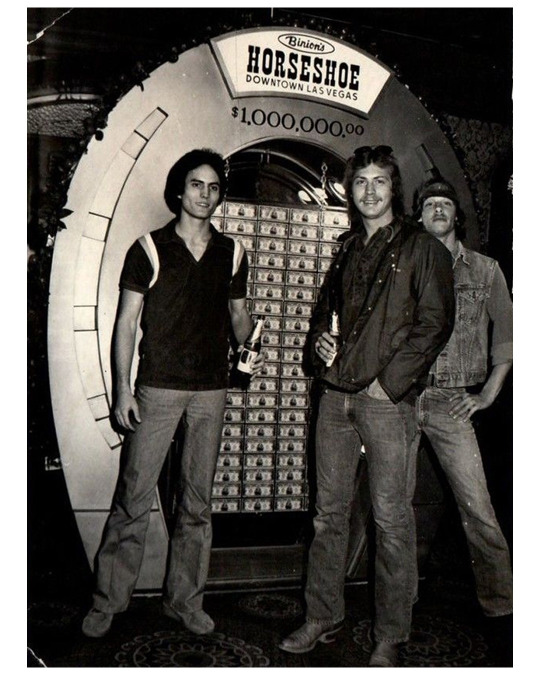
The second $1M display at the Horseshoe Club, 70s-80s. The second display was at the casino from June 1969 to Dec. '99.
(3) kids from Western High c. 79-81. (4) Connie Koepke, Willie Nelson, Mary McCreary, Leon Russell, Zena Hanley, Ted Binion. (5) Chill Wills & unknown. (6) unknown, John O'Hurley, Bryan Cranston, S. Sobel, unknown. (7) D. Dorsey.


Dec. '99 – Removing the cash from the display, and the empty display. Photos shared by Michelle Richardson, and Bobby Fescher, via Nevada Armored Transport.
Sources include: New Bingo Room to Open Tonight at Horseshoe Club. Review-Journal, 12/10/54; D. Strow. Horseshoe retires $1 million display. Las Vegas Sun, 1/20/2000; H. Hickson. One Million Dollar Horseshoe. 2008; A Look At Benny Binion's Wild Ride. KNPR, 10/7/2014; Horseshoe's 2nd $1M Display. Nevada Armored Transport, 2017.
49 notes
·
View notes
Text
49 years ago today
SS Arthur M Anderson: "Fitzgerald, this is the Anderson. Have you checked down?"
SS Edmund Fitzgerald: "Yes we have."
Anderson: "Fitzgerald, we are about 10 miles behind you, and gaining about 1 1/2 miles per hour. Fitzgerald, there is a target 19 miles ahead of us. So the target would be 9 miles on ahead of you."
Fitzgerald: "Well, am I going to clear?"
A: "Yes. He is going to pass to the west of you."
F: "Well, fine."
A: "By the way, Fitzgerald, how are you making out with your problem?"
F: "We are holding our own."
A: "Okay, fine. I'll be talking to you later."
The crew of the Edmund Fitzgerald would never speak to anyone outside of the ship again. After the Fitzgerald entered a squall and was obscured from the Anderson's radar. Some time shortly thereafter the Edmund Fitzgerald sank with all hands aboard.

Michael E. Armagost, 37, Third Mate, from Iron River, Wisconsin
Frederick J. Beetcher, 56, Porter, from Superior, Wisconsin
Thomas D. Bentsen, 23, Oiler, from St. Joseph, Michigan
Edward F. Bindon, 47, First Assistant Engineer, from Fairport Harbor, Ohio
Thomas D. Borgeson, 41, Maintenance Man, from Duluth, Minnesota
Oliver J. Champeau, 41, Third Assistant Engineer, from Sturgeon Bay, Wisconsin
Nolan S. Church, 55, Porter, from Silver Bay, Minnesota
Ransom E. Cundy, 53, Watchman, from Superior, Wisconsin
Thomas E. Edwards, 50, Second Assistant Engineer, from Oregon, Ohio
Russell G. Haskell, 40, Second Assistant Engineer, from Millbury, Ohio
George J. Holl, 60, Chief Engineer, from Cabot, Pennsylvania
Bruce L. Hudson, 22, Deck Hand, from North Olmsted, Ohio
Allen G. Kalmon, 43, Second Cook, from Washburn, Wisconsin
Gordon F. MacLellan, 30, Wiper, from Clearwater, Florida
Joseph W. Mazes, 59, Special Maintenance Man, from Ashland, Wisconsin
John H. McCarthy, 62, First Mate, from Bay Village, Ohio
Ernest M. McSorley, 63, Captain, from Toledo, Ohio
Eugene W. O’Brien, 50, Wheelsman, from Toledo, Ohio
Karl A. Peckol, 20, Watchman, from Ashtabula, Ohio
John J. Poviach, 59, Wheelsman, from Bradenton, Florida
James A. Pratt, 44, Second Mate, from Lakewood, Ohio
Robert C. Rafferty, 62, Steward, from Toledo, Ohio
Paul M. Riippa, 22, Deck Hand, from Ashtabula, Ohio
John D. Simmons, 63, Wheelsman, from Ashland, Wisconsin
William J. Spengler, 59, Watchman, from Toledo, Ohio
Mark A. Thomas, 21, Deck Hand, from Richmond Heights, Ohio
Ralph G. Walton, 58, Oiler, from Fremont, Ohio
David E. Weiss, 22, Cadet, from Agoura, California
Blaine H. Wilhelm, 52, Oiler, from Moquah, Wisconsin
6 notes
·
View notes
Text


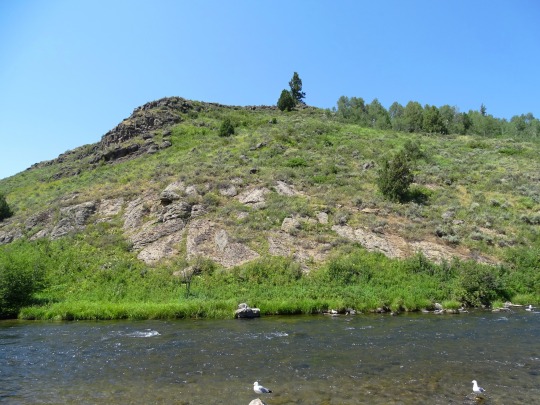
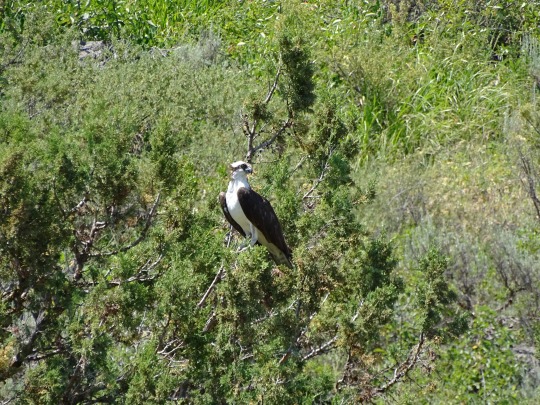
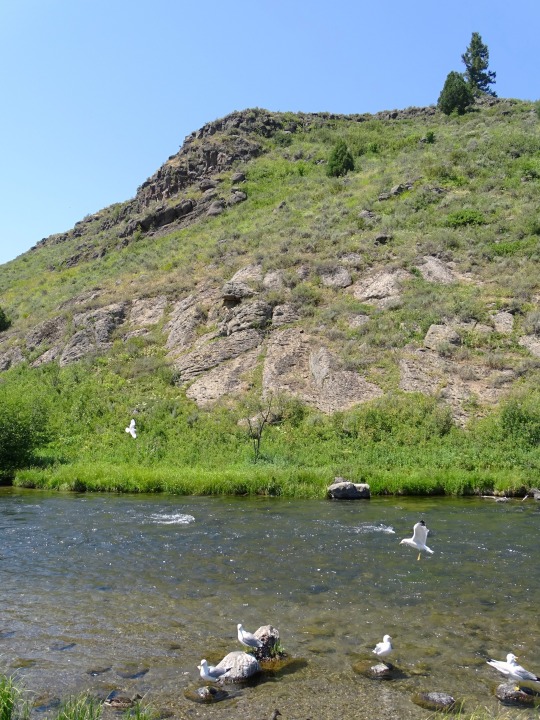



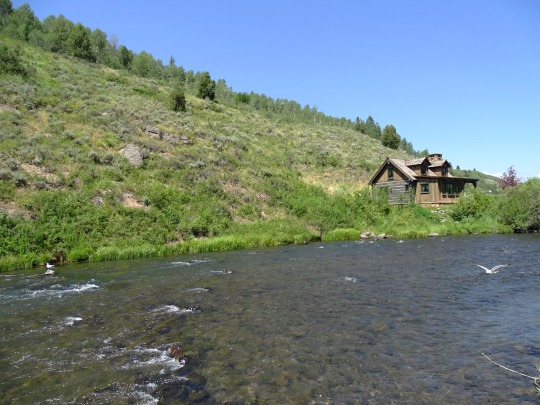
Warm River, ID (No. 2)
Fremont County is a county located in the U.S. state of Idaho. As of the 2020 census the county had a population of 13,388. The county seat and largest city is St. Anthony. The county was established in 1893, and was named for the explorer John C. Frémont. Fremont County is part of the Rexburg, Idaho micropolitan area, which is also included in the Idaho Falls metropolitan area.
Fremont County was established in 1893 when Bingham County was partitioned. It is named for John C. Frémont.
According to the U.S. Census Bureau, the county has a total area of 1,896 square miles (4,910 km2), of which 1,864 square miles (4,830 km2) is land and 32 square miles (83 km2) (1.7%) is water. The southern part of the county covers the northeastern tip of the Snake River Basin, with the mountains of the continental divide forming its northern boundary. Montana lies to the north, and Wyoming to the east. A portion of Yellowstone National Park reaches into the county.
Source: Wikipedia
#Warm River#Fremont County#Idaho#Fred and Berta Lewies Memorial Trout Feeding Site#Ashton#Mesa Falls Scenic Byway#Osprey#Ring-billed gull#travel#original photography#vacation#tourist attraction#landmark#cityscape#architecture#landscape#countryside#river bank#flora#fauna#wildlife#bird#USA#summer 2024
6 notes
·
View notes
Text
what was your first cosplay?
even if the word "cosplay" wasn't around yet or you didn't know it! i am 95% sure my first one was a logan's run dress in green, c 1976 or early 1977. it was patterned after the one farrah fawcett wore (which i don't think was green) but the first one i have a photo of is leia at an event at the galactic starport in fremont (calif) in 77 left to right jen (also as leia), merrick as a sandman, me as leia, and in front john as a creature from the cantina (i can't remember the person far right's name)

2 notes
·
View notes
Text
Birthdays 1.21
Beer Birthdays
Gottlieb Storz (1852)
Ludwig Thoma (1867)
Grigori Rasputin, politician, "the mad monk" (1869)
Jinx Falkenberg, the 1st Miss Rheingold (1919)
Tom Bedell (1948)
Five Favorite Birthdays
Ethan Allen; Revolutionary, leader of Vermont's Green Mountain Boys (1738)
Roger Nash Baldwin; founded ACLU (1884)
"Wolfman" Jack; Radio DJ (1939)
Jack Nicklaus; golfer (1940)
Telly Savalas; actor (1924)
Famous Birthdays
Paul Allen; Microsoft co-founder (1953)
Robby Benson; actor (1956)
Konrad Emil Bloch; biochemist (1912)
Emma Bunton; singer, "Spice Girl" (1976)
Barney Clark; 1st artificial heart recipient (1921)
Geena Davis; actor (1957)
Mac Davis; country singer, actor (1942)
Christian Dior; fashion designer (1905)
Placido Domingo; opera tenor (1941)
Jill Eikenberry; actor (1947)
John Fitch; steamboat inventor (1743)
Lola Flores; singer, actor (1925)
John Fremont; explorer, politician (1813)
Richie Havens; rock singer (1941)
Benny Hill; English comedian (1925)
Jimmy Ibbotson; country singer (1947)
Ito; Spanish footballer (1975)
"Stonewall" Jackson; Union general (1824)
Jam Master Jay; musician,, "Run DMC" (1965)
Jeff Koons; artist (1955)
Ken Leung; actor (1970)
J. Carrol Naish; actor (1897)
Billy Ocean; R&B singer (1950)
Hakeem Abdul Olajuwon; Houston Rockets C (1963)
Cat Power; pop singer (1972)
Steve Reeves; actor, bodybuilder (1926)
Paul Scofield; actor (1922)
Edwin Starr; rock singer (1941)
Karl Wallenda; acrobat, circus performer (1905)
William Wrigley III; chewing gum magnate (1933)
1 note
·
View note
Text
Dave Benner
It's amazing to me the adulation Lincoln gets for allegedly waging a war against slavery, when the most devout abolitionists of his time denounced him continually for NOT doing the same things to undermine the institution that he is now given credit for doing. Even his most prominent biographers, including Pulitzer-Prize winning author David Donald, recognize this.
Examples:
-He promoted a constitutional amendment (the Corwin Amendment) that would have authorized slavery in all states, and made such a condition unamendable for all time (this was constitutionally dubious, but nevertheless what he supported).
-He continued to enforce the egregious Fugitive Slave Act of 1850, which forced runaway slaves to be returned to their masters without due process, until March of 1862.
-He relieved John C. Fremont of his command when he enacted a slave emancipation in Missouri, then refused to reverse it when Lincoln ordered him to do so.
-He pushed to incorporate West Virginia into the union with a constitution that made it a slave state with gradual manumission rather than a free state that prohibited slavery.
-He happily retained the slave states of Missouri, Delaware, Kentucky, and Maryland in the union, and specifically exempted them from slave manumission in the supposedly abolitionist Emancipation Proclamation.
-In negotiations with Confederate diplomats (namely at Hampton Roads Conference), he offered concessions that included compensated manumission, and offered the possibility that southern states could ratify the future 13th Amendment after a period of several decades rather than immediately.
Despite popular belief, many of the country's leading abolitionists viewed Lincoln as a pro-slavery shill, refused to work with him, and publicly criticized him. Despite this, he is now deemed the "Great Emancipator" and essentially deified through the American civil religion his death helped inspire.
2 notes
·
View notes
Text
Please don't vote third party in the presidential election. The winner is going to be a Democrat or a Republican. That's unfortunately how our presidential elections work. We have a two party system.
In 2020, the best showing for a third party candidate was Libertarian Jo Jorgensen with 1.2% of the popular vote. She was also the only third party candidate who was on the ballot in all 50 states.
The last time a third party candidate got over 5% of the popular vote was 1992 - Ross Perot with 18.9%. The last time a third party candidate won a state was 1968 - segregationist George Wallace, who won 5 states in the South. The last time a third party candidate did well enough in a presidential election to supplant one of the two major parties was 1856 - Republican John C. Fremont.
You can have a say in whether the Democratic candidate or the Republican candidate wins, or you can vote third party and let other people choose your president for you. And all the politicians and election analysts won't know why you voted third party, they'll just know you did.
genuinely cannot comprehend how democrats are gonna convince the youth to vote for them again in november after they literally let the police beat the shit outta them for protesting against genocide
21K notes
·
View notes
Text
This emancipation proclamation predates President Lincoln’s
American Battlefield Trust illustration This article came into my feed the other day. “In 1861, Major General John C. Fremont issued an emancipation proclamation in St. Louis, freeing slaves in Missouri, a bold move that predated President Abraham Lincoln’s more famous Emancipation Proclamation by two years. Fremont, known as the ‘Pathfinder’ for his explorations of the West, was appointed by…

View On WordPress
0 notes
Text
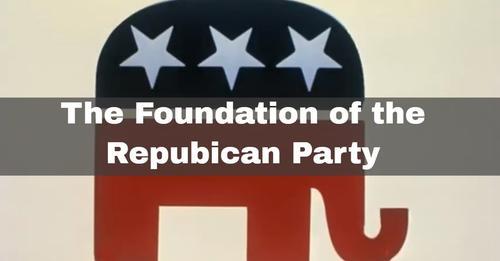
Republican Party founded In Ripon, Wisconsin, former members of the Whig Party meet to establish a new party to oppose the spread of slavery into the western territories. The Whig Party, which was formed in 1834 to oppose the “tyranny” of President Andrew Jackson, had shown itself incapable of coping with the national crisis over slavery.
With the successful introduction of the Kansas-Nebraska Bill of 1854, an act that dissolved the terms of the Missouri Compromise and allowed slave or free status to be decided in the territories by popular sovereignty, the Whigs disintegrated. By February 1854, anti-slavery Whigs had begun meeting in the upper midwestern states to discuss the formation of a new party. One such meeting, in Wisconsin on March 20, 1854, is generally remembered as the founding meeting of the Republican Party.
The Republicans rapidly gained supporters in the North, and in 1856 their first presidential candidate, John C. Fremont, won 11 of the 16 Northern states. By 1860, the majority of the Southern slave states were publicly threatening secession if the Republicans won the presidency. In November 1860, Republican Abraham Lincoln was elected president over a divided Democratic Party, and six weeks later South Carolina formally seceded from the Union. Within six more weeks, five other Southern states had followed South Carolina’s lead, and in April 1861 the Civil War began when Confederate shore batteries under General P.G.T. Beauregard opened fire on Fort Sumter in South Carolina’s Charleston Harbor.
The Civil War firmly identified the Republican Party as the party of the victorious North, and after the war the Republican-dominated Congress forced a “Radical Reconstruction” policy on the South, which saw the passage of the 13th, 14th, and 15th amendments to the Constitution and the granting of equal rights to all Southern citizens. By 1876, the Republican Party had lost control of the South, but it continued to dominate the presidency until the election of Franklin D. Roosevelt in 1933.
20th March 1854: U.S. Republican Party founded at a meeting in a schoolhouse in Wisconsin https://www.youtube.com/watch?v=5HkQpJ1AWUQ
0 notes
Photo
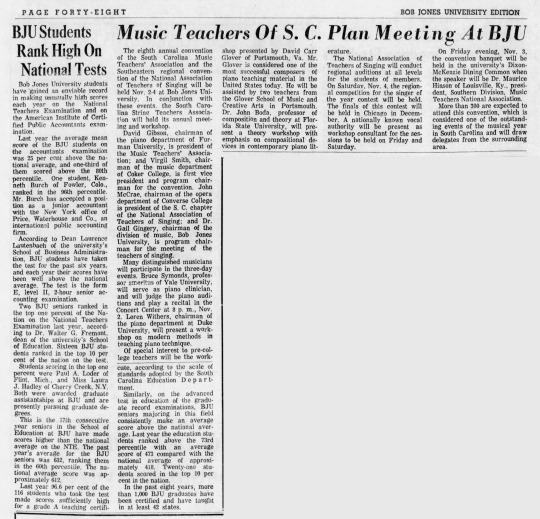
Two lengthy articles here. One is typical Division of Music information, and the other sounds really odd in retrospect.
BJU Student Rank High On National Tests
Bob Jones University students have gained an enviable record in making unusually high scores each year on the National Teachers Examination and on the American Institute of Certified Public Accountants examination.
Last year the average mean score of the BJU students on the accountants examination was 25 per cent above the national average, and one-third of them scored above the 80th percentile. One student, Kenneth Burch of Fowler, Colo., ranked in the 96th percentile. Mr. Burch has accepted a position as a junior accountant with the New York office of Price, Waterhouse and Co., an international public accounting firm.
Kenneth Eugene Burch is a member of the Class of 1967. He married Jean Anna Hicks, a Home Ec major from the Class of 1968 in the Spring of 1968.

According to Dean Laurence Lautenbach of the university's School of Business Administration, BJU students have taken the test for the past six years, and each year their scores have been well above the national average. The test is the form E, level II, 2-hour senior accounting examination.
Two BJU seniors ranked in the top one percent of the Nation on the National Teachers Examination last year, according to Dr. Walter G. Fremont, dean of the university's School of Education. Sixteen BJU students ranked in the top 10 per cent of the nation on the test.
Students scoring in the top one percent were Paul A. Loder of Flint, Mich, and Miss Laura J. Hadley of Cherry Creek, N.Y. Both were awarded graduate assistantships at BJU and are presently pursuing graduate degrees.
Paul Allen Loder was a Bible major but was scheduled to teach Math the next year. He married Sandra Gehman in June 1967.
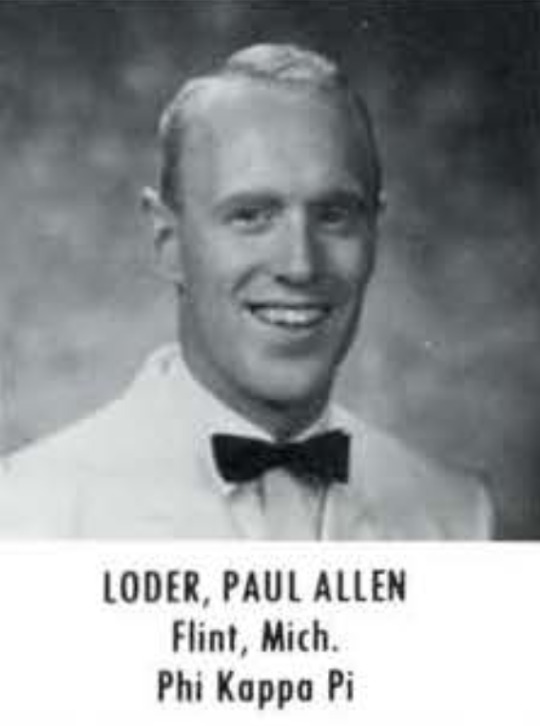
Loder did teach one year at BJU, and he now is at Indiana Baptist College.
Laura Jane Hadley was a Christian Education graduate in 1967, and she did teach for two years. And I can’t find her after that.
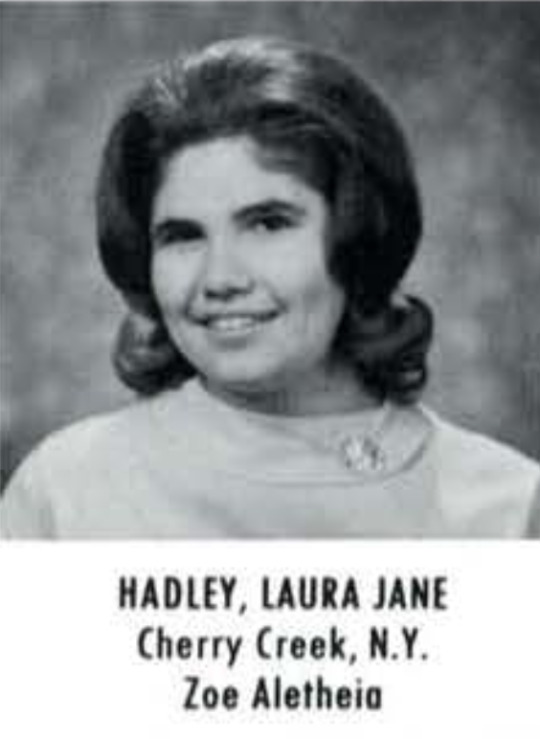
This is the 17th consecutive year seniors in the School of Education at BJU have made scores higher than the national average on the NTE. The past year's average for the BJU seniors was 632, ranking them in the 60th percentile. The national average score was approximately 612.
Last year 96.6 per cent of the 116 students who took the test made scores sufficiently high for a grade A teaching certificate, according to the scale ot standards adopted by the South Carolina Education Department.
Similarly, on the advanced test in education of the graduate record examinations, BJU seniors majoring in this field consistently make an average score above the national aver-age. Last year the education students ranked above the 73rd percentile with an average score of 473 compared with the national average of approximately 418. Twenty-one students scored in the top 10 per cent in the nation.
In the past eight years, more than 1,000 BJU graduates have been certified and have taught in at least 42 states.
Music Teachers of S. C. Plan Meeting at BJU
The eighth annual convention of the South Carolina Music Teachers' Association and the Southeastern regional convention of the National Association of Teachers of Singing will be held Nov. 24 at Bob Jones University. In conjunction with these events. the South Carolina String Teachers Association will hold its annual meeting and workshop.
David Gibson, chairman of the piano department of Furman University, is president of the Music Teachers' Association; and Virgil Smith, chairman of the music department of Coker College, is first vice president and program chairman for the convention. John McCrae, chairman of the opera department of Converse College is president of the S. C. chapter of the National Association of Teachers of Singing; and Dr. Gail Gingery, chairman of the division of music, Bob Jones University, is program chairman for the meeting of the teachers of singing.
Many distinguished musicians will participate in the three-day events. Bruce Symonds, professor emeritus of Yale University, will serve as piano clinician, and will judge the piano auditions and play a recital in the Concert Center at 8 p. m., Nov. 2. Loren Withers, chairman of the piano department at Duke University, will present a workshop on modern methods in teaching piano technique.
Of special interest to pre-college teachers will be the work shop presented by David Carr Glover of Portsmouth, Va. Mr. Glover is considered one of the most successful composers of piano teaching material in the United States today. He will be assisted by two teachers from the Glover School of Music and Creative Arts in Portsmouth.
Dr. John Boda, professor of composition and theory at Florida State University, will present a theory workshop with emphasis on compositional devices in contemporary piano literature.
The National Association of Teachers of Singing will conduct regional auditions at all levels for the students of members. On Saturdav, Nov. 4, the regional competition for the singer of the year contest will be held. The finals of this contest will be held in Chicago in December. A nationally known vocal authority will be present as workshop consultant for the sessions to be held on Friday and Saturday.
On Friday evening, Nov. 3, the convention banquet will be held in the university's Dixon-McKenzie Dining Common when the speaker will be Dr. Maurice Hinson of Louisville, Ky., president, Southern Division, Music Teachers National Association.
More than 300 are expected to attend this convention, which is considered one of the outstanding events of the musical year in South Carolina and will draw delegates from the surrounding area.
#Bob Jones University#1967#Greenville News#YeahTHATGreenville#Advertisement#Anniversary#Paul Allen Loder#Indiana Baptist College#Laura Jane Hadley
0 notes
Photo
George Strock (3 de julho de 1911 – 23 de agosto de 1977) foi um fotojornalista durante a Segunda Guerra Mundial quando tirou uma foto de três soldados americanos que foram mortos durante a Batalha de Buna-Gona na praia de Buna. Tornou-se a primeira fotografia a retratar tropas americanas mortas no campo de batalha a ser publicada durante a Segunda Guerra Mundial. O correspondente da Life, Cal Whipple, foi até a Casa Branca para obter permissão para imprimir a imagem.
Strock começou como fotógrafo enquanto estudava fotojornalismo na John C. Fremont High School em Los Angeles. Depois do ensino médio, Strock fotografou celebridades de Hollywood, crimes e esportes para o Los Angeles Times antes de ingressar na revista Life em 1940.

George Strock: Sailors, Bermudas (1940) LIFE
349 notes
·
View notes
Text
Week 6--Earning a living
With roots in Crawford County, it should not be a surprise that I have several ancestors who worked in various aspects of the oil business. Crawford County, Illinois had an oil boom in the early years of the 20th century. This affected nearly every family in Crawford County, in one way or another. You can still see the pumpjacks (I called them grasshoppers when I was a kid) in many rural areas of the county. And I believe my mother still gets an occasional (small) check from a long-ago ancestor’s well.

(Photo from Library of Congress website)
For starters, two of my great-grandfather’s sisters married two brothers of John W. Shire, whose 1906 toss of an old whiskey bottle south of Stoy marked the site of the first oil well in Crawford County, starting the oil boom. The oil boom lead to a construction boom, and those brothers of John Shire and two of their brothers-in-law (my great-grandfather Earnest Bashears and another brother, W.C. “Tuckie” Bashears) were construction workers at this time.
My maternal grandfather C. Scott Bashears was enumerated as a blacksmith for an oil well supply company in the 1940 census and was a tank car repairman in the 1950 census. His younger brother worked in a laboratory at the refinery and one of my grandfather’s sisters married a man who worked in the oil industry and they moved to Wyoming.
My maternal grandmother Dorothy (Marbry) Bashears worked in the office of Lincoln Oil Company before my mom was born. Her family was very involved in the oil business. As a child in the 1910s and 1920s, my grandmother lived in Oklahoma where her father Will Marbry worked as a wildcatter. He traveled throughout the Great Plains drilling for oil in previously unexplored areas. My great-grandmother, Bertha (Hill) Marbry occasionally accompanied him on his expeditions.

From the back of the photo: “ 1st well ‘the Winkle Man’. The one with me in the picture is ��Mrs. Perrin’ the lady that was with us at Dry Creek and one of the drillers and a tool dresser.” My great-grandmother Bertha is on the far right. The Winkleman Dome Oil Field is in Fremont County, Wyoming, about 30 miles from Lander, Wyoming. Winkleman was first drilled in 1917.
After the family returned to Crawford County in the mid-1920s, my great-grandfather Will worked as a machinist at the Ohio Oil Company refinery in Robinson, later Marathon Oil. He and a coworker patented a metering valve in 1930. Two of my grandmother’s brothers, Zeb and Bob, worked at the refinery. Lastly, a favorite cousin (a son of my grandmother’s sister) worked as an engineer, and later in upper management, for Marathon Oil Company.

My paternal family also had ties to the oil industry, starting with my great-grandfather Rollie Wiseman. He grew up a couple of miles north of Stoy and by 1930 was working in the oil fields of Stoy as a roustabout. In fact, while walking home from lunch at a tavern in Stoy in 1963, he felt ill and died near the oil field pump station.
A tantalizing tangent to the oil industry: In early December 1911 the bank at Stoy was blown open with dynamite and robbed of about $1500. No one thought anything of the early morning booms; loud noises were common in the oil fields. Because of something said to my dad by his dad Ray (Rollie’s son) the family story is that Rollie had something to do with the robbery, or had inside information about the robbery. Rollie was, let’s say, an interesting man.
Rollie’s son (my paternal grandfather) Ray Wiseman worked at the Ohio Oil/Marathon refinery for 44 years. In 1950 he was a stillman. My grandfather had two brothers and they both worked in the oil business, too. Donald worked at the refinery in Robinson and Clifford worked elsewhere in Illinois.
The Marathon Oil refinery remains one of Crawford County’s largest employers, employing approximately 650 people with the ability refine up to 253,000 barrels of crude oil per day. I wonder what John W. Shire would think of the legacy of his random whiskey bottle toss today.

(Photo from the Marathon Petroleum website)
0 notes